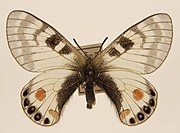 Although Sikkim is one of the smallest Himalayan states, with an area of 7,299 sq. km. the biodiversity has given Sikkim an unique status. For example, within 30 km of Tholung Valley the altitude rises from 600 m to 5,500 m. Due to this steepness of the mountain and the geographical and climatic conditions, the floral and faunal diversity ranges from tropical species to high altitude cold desert species.
Although Sikkim is one of the smallest Himalayan states, with an area of 7,299 sq. km. the biodiversity has given Sikkim an unique status. For example, within 30 km of Tholung Valley the altitude rises from 600 m to 5,500 m. Due to this steepness of the mountain and the geographical and climatic conditions, the floral and faunal diversity ranges from tropical species to high altitude cold desert species.
Of total of about 1,400 butterflies recorded from the Indian Sub-continent almost 50% of butterflies are recorded from Sikkim. Of the total area of Sikkim 40% (North Sikkim) is almost inhabitable and is covered with snow for about 4-8 months to perpetual snow and unsuitable for any life. About 30% of the total area of Sikkim which occupies the altitudinal zone from about 200-1,800 m is represented by about more than 75% species butterflies of Sikkim. Remaining species are found in the in-between zone and some of them overlap all the zones.![[mauretanica-3u.jpg]](http://www.funet.fi/pub/sci/bio/life/insecta/lepidoptera/ditrysia/papilionoidea/papilionidae/papilioninae/papilio/_mauretanica-3u.jpg) .The subfamily Amathusiinae occurs mainly below 900 m. The region between 600-1,800 m is occupied by the typical hilly region butterflies. These butterflies have affinity to Oriental fauna. The Swallowtails also abound this region. The zone between 1,800-3,500 m has butterfly fauna typical of temperate zones and has affinity to the Palaearctic fauna. But the most diversified is the subfamily Satyrinae, particularly the tribes Lethini and Satyrini. Foresters, Walls, Golden and Silver Forks are numerous. As many as 36 species of tribe Lethini are found in Sikkim. Of the Swallowtails very few larger butterflies occur in this region and include the Krishna and Blue Peacocks. The
Yellow Swallowtail in Sikkim has been recorded only from the altitudes above 3,000 m, although it occurs up to 2,000 m in other parts of Himalaya.
.The subfamily Amathusiinae occurs mainly below 900 m. The region between 600-1,800 m is occupied by the typical hilly region butterflies. These butterflies have affinity to Oriental fauna. The Swallowtails also abound this region. The zone between 1,800-3,500 m has butterfly fauna typical of temperate zones and has affinity to the Palaearctic fauna. But the most diversified is the subfamily Satyrinae, particularly the tribes Lethini and Satyrini. Foresters, Walls, Golden and Silver Forks are numerous. As many as 36 species of tribe Lethini are found in Sikkim. Of the Swallowtails very few larger butterflies occur in this region and include the Krishna and Blue Peacocks. The
Yellow Swallowtail in Sikkim has been recorded only from the altitudes above 3,000 m, although it occurs up to 2,000 m in other parts of Himalaya. ![[saharae-2u.jpg]](http://www.funet.fi/pub/sci/bio/life/insecta/lepidoptera/ditrysia/papilionoidea/papilionidae/papilioninae/papilio/_saharae-2u.jpg) The zone beyond 3,000 m is occupied by a very few specialised species which are adapted to harsh climatic conditions and have affinity to the Palaearctic fauna. They include Apollos and Yellow Swallowtail of the Papilionidae.A few butterflies on account of being polyphagus are found from sea level to
the high mountains up to about 4,500 m. They are the Indian and the Large Cabbage Whites, Tortoiseshells, Indian Red Admiral, Painted Lady, Dark Clouded Yellow etc.
The zone beyond 3,000 m is occupied by a very few specialised species which are adapted to harsh climatic conditions and have affinity to the Palaearctic fauna. They include Apollos and Yellow Swallowtail of the Papilionidae.A few butterflies on account of being polyphagus are found from sea level to
the high mountains up to about 4,500 m. They are the Indian and the Large Cabbage Whites, Tortoiseshells, Indian Red Admiral, Painted Lady, Dark Clouded Yellow etc.
The Geographic position, i.e. Sikkim is bound by high mountains of more than 4,000 m on three sides, has led to isolation of the the' population occurring in Sikkim. Probably due to this
reasons many of them have become distinct subspecies and forms. Sikkim is renowned for its natural beauty.There are many Oriental species which do not occur west of Sikkim. The
reason for this may be that the great North-South ridge of the Khangchenzonga spur and Singalila act as barrier for dispersal of the species. Similarly many Palaearctic species like Lassiomata, Hipparchia and Dallacha have not been recorded east of Nepal.
Sikkim is renowned for its natural beauty.There are many Oriental species which do not occur west of Sikkim. The
reason for this may be that the great North-South ridge of the Khangchenzonga spur and Singalila act as barrier for dispersal of the species. Similarly many Palaearctic species like Lassiomata, Hipparchia and Dallacha have not been recorded east of Nepal.
Many of the subspecies are known only from Bhutan and Sikkim. Infact the following species have been so far recorded only from Sikkim -Lethe trisigmata, Lethe atkinsoni, and that too from high altitudes of Lachen and Lachung Valleys. But this does not necessarily mean they are endemic to Sikkim only as the surrounding regions like Bhutan, Arunachal Pradesh, South Tibet has similar biodiversity. But hardly these areas have been explored in detail for butterfly fauna also a very few records are available from these regions in last hundred years.
Current status:: Compared to earlier records definitely there is a great reduction in numbers as well as species. The main reasons for this are increase in human population and developmental activities and urbanisation. The lower valleys particularly in those areas which are less disturbed still have a great number of species. The best altitude to observe butterflies is between 900-1,800 m. Most of the swallowtails, nymphalids are abundant here. The Amatheusiinae needs a special survey to assess the presence of these species in Sikkim as most of the moist bamboo forest habitats are lost.
